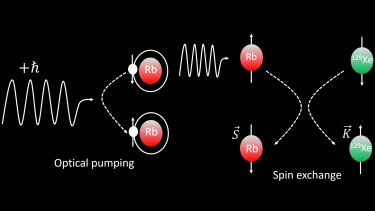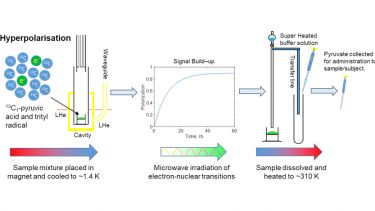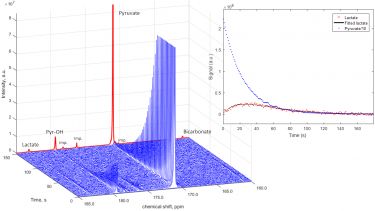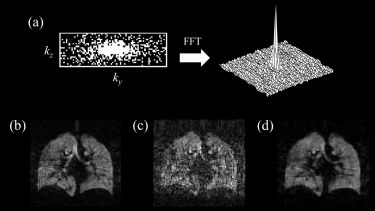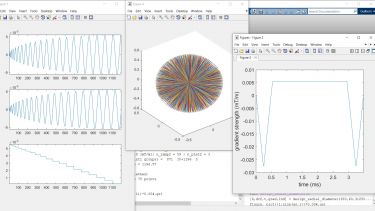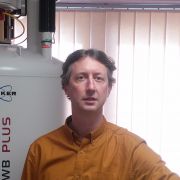Hyperpolarisation
Our research in to hyperpolarisation methodology is focused on two main topics: hyperpolarisation physics and pulse sequence development.

Overview
Our research in to hyperpolarisation methodology is focused on two main topics:
- Hyperpolarisation physics:
- Polarised noble gases: design and construction of spin-exchange optical pumping polarisers, using optimised physics and engineering parameters to provide maximum polarisation of hyperpolarised noble gases for clinical lung MRI.
- Dynamic Nuclear Polarisation: hyperpolarisation of isotopically labelled molecules for the tracking of in vivo metabolism. Images or spectra are rapidly acquired to observe the conversion of a tracer molecule to its metabolic products. Applications include preclinical oncology and cellular metabolism.
- Pulse sequence development:
- Design and optimisation of MR pulse sequences for rapid, high sensitivity functional lung and metabolic imaging.
Hyperpolarisation of noble gases: spin-exchange optical pumping
The working principle behind the hyperpolarisation of noble gases is simple: a hyperpolariser transforms select inert gases, e.g. 3He and 129Xe, into a hyperpolarised state with circularly polarised laser light. This process, known as spin-exchange optical pumping (SEOP), leaves the gases chemically the same, while physically their nuclei are left magnetically aligned (hyperpolarised). This hyperpolarisation process makes it possible to produce high-resolution magnetic resonance (MR) images of 3He and 129Xe (see figure below), which would be impossible under normal circumstances owing to the density of these gases being ~4 orders of magnitude lower than the density of tissues normally visualised on a conventional 1H MRI scan.
While the basic principle of SEOP is simple, the underlying physical mechanisms governing the hyperpolarisation process are strongly coupled. This makes the optimisation of hyperpolarised gas generation a challenging, multi-parameter problem. Much of our research in the hyperpolarisation lab is dedicated to better understanding of the physics of SEOP for clinical-scale production (2–4 litres of xenon gas per hour) of polarised 129Xe, as well as developing experiments and theoretical models to resolve the widely-reported discrepancy between theoretical and experimental polariser performance.
Dynamic Nuclear Polarisation
Dynamic Nuclear Polarisation (DNP) is method for detecting and imaging cellular metabolism. DNP is versatile in that it can be applied to a range of atoms, particularly spin ½ nuclei, e.g. 13C and 15N. Similar to SEOP in noble gas hyperpolarisation, DNP uses the spin polarisation of electrons at ultra-low temperature, 1—2 K. Through microwave irradiation, the electron polarisation is transferred to a target molecule. This boosts the MR signal of the target molecule by 3—4 orders of magnitude. The sample is then rapidly returned to room temperature, where its signal can be monitored over time.
Its main application is in understanding metabolism of different organs, tissue or cells. The hyperpolarised molecule is administered to these, where it is metabolised to form daughter metabolic products that exhibit distinct NMR resonances, and can therefore be detected separately.
One of the mainstay applications of the technique is hyperpolarised pyruvate. This molecule is important in detecting the relative importance of glycolytic metabolism (lactate) and oxidative phosphorylation (bicarbonate). High levels of lactate are a marker of cancer, and when combined with imaging DNP can detect tumour cells and their response to response to treatment. The technique has been applied to other target organs, including the heart, kidney and brain.
DNP is a complimentary technique that works in conjunction with an MRI scanner. The HyperSense instrument is state of the art; with fully automated sample handling to maximise both the available signal and the range of metabolically active molecules that can be observed.
MRI Pulse Sequence Development
The magnetisation of hyperpolarised nuclei decays over time, and through excitation by radiofrequency pulses, and is non-renewable; this behaviour is in stark contrast to conventional 1H MRI. In addition, as respiratory motion can severely corrupt MR images, it is beneficial to acquire hyperpolarised gas MRI during a short breath-hold after inhalation.
The design and optimisation of rapid MR pulse sequences for lung imaging with hyperpolarised gases is thus crucial to obtain high quality images and maximise the functional information attainable within a single breath-hold, and the lifetime of the polarisation.
Our group have established expertise in:
- Acceleration techniques, including random undersampling of k-space and compressed sensing reconstruction, and parallel imaging
- Non Cartesian sampling of k-space (e.g. with radial or spiral trajectories)
- Balanced steady state free precession sequences
- Methods for simultaneous imaging of multiple nuclei during a single breath-hold (1H, 3He, 129Xe)
- Pulse programming for GE Healthcare (EPIC), Philips (PPE) and Bruker MR systems
People, Projects & Publications
- People
- Current Projects / Grants
-
- 04/2015—03/2023. Expansion of state-of-the-art MR imaging infrastructure for pulmonary disease stratification: POLARIS. MRC - Resources and infrastructure Research Grant. PI: Wild
- 06/2016—05/2024. Xenon gas recycling project. Linde gases. PI: Wild
- Past Projects / Grants
-
- 11/2013—10/2018. Translating novel pulmonary MR imaging methods in to clinical practice. NIHR - Research Professorship. PI: Wild
- 10/2012—09/2016. Hyperpolarised 129Xe Magnetic Resonance Imaging Techniques for Assessment of Human Lung Function. MRC - CASE Industrial Studentship with GE Healthcare. PI: Wild
- 10/2006—10/2011. Enhancement of Sensitivity in the MRI of Hyperpolarised Noble Gases. EPSRC - Advanced Fellowship. PI: Wild
- Key publications
-
- Collier GJ, Hughes PJC, Horn CF, Chan HF, Tahir B, Norquay G, Stewart NJ, Wild JM (2019) Single breath‐held acquisition of coregistered 3D 129Xe lung ventilation and anatomical proton images of the human lung with compressed sensing. Magnetic Resonance in Medicine, 82(1), 342-347.
- Maunder A, Rao M, Robb F, Wild JM (2019) Optimization of steady‐state free precession MRI for lung ventilation imaging with 19F C3F8 at 1.5T and 3T. Magnetic Resonance in Medicine, 81(2), 1130-1142.
- Norquay G, Collier GJ, Rao M, Stewart NJ & Wild JM (2018) Xe129-Rb Spin-Exchange Optical Pumping with High Photon Efficiency. Physical Review Letters, 121(15).
- Chan HF, Stewart NJ, Parra-Robles J, Collier GJ & Wild JM (2017) Whole lung morphometry with 3D multiple b‐value hyperpolarized gas MRI and compressed sensing. Magnetic Resonance in Medicine, 77(5), 1916-1925.
- Stewart NJ, Norquay G, Griffiths PD & Wild JM (2015) Feasibility of human lung ventilation imaging using highly polarized naturally abundant xenon and optimized three-dimensional steady-state free precession. Magnetic Resonance in Medicine, 74(2), 346-352.
- Norquay G, Parnell SR, Xu X, Parra-Robles J & Wild JM (2013) Optimized production of hyperpolarized 129Xe at 2 bars for in vivo lung magnetic resonance imaging. Journal of Applied Physics, 113(4), 044908-044908.
- Wild JM, Marshall H, Xu X, Norquay G, Parnell SR, Clemence M, Griffiths PD, Parra-Robles J (2013) Simultaneous Imaging of Lung Structure and Function with Triple-Nuclear Hybrid MR Imaging. Radiology, 267(1), 251-255.
- Deppe MH, Wild JM (2012) Variable flip angle schedules in bSSFP imaging of hyperpolarized noble gases. Magnetic resonance in Medicine, 67(6), 1656-1664.
- Deppe MH, Parra‐Robles J, Marshall H, Lanz T, Wild JM (2011), A flexible 32‐channel receive array combined with a homogeneous transmit coil for human lung imaging with hyperpolarized 3He at 1.5 T. Magnetic resonance in Medicine, 66(6), 1788-1797.
- Marshall H, Ajraoui S, Deppe MH, Parra‐Robles J, Wild JM (2012) K‐space filter deconvolution and flip angle self‐calibration in 2D radial hyperpolarised 3He lung MRI. NMR in Biomedicine, 25(2), 389-399.
- Ajraoui S, Lee KJ, Deppe MH, Parnell SR, Parra‐Robles J, Wild JM (2010) Compressed sensing in hyperpolarized 3He Lung MRI. Magnetic resonance in Medicine, 63(4), 1059-1069.
- Parnell SR, Deppe MH, Parra-Robles J, Wild JM (2010) Enhancement of 129Xe polarization by off-resonant spin exchange optical pumping. Journal of Applied Physics, 108, 064908.
- Wild JM, Teh K, Woodhouse N, Paley MNJ, Fichele S, de Zanche N, Kasuboski L (2006) Steady-state free precession with hyperpolarized 3He: Experiments and theory. Journal of Magnetic Resonance, 183(1), 13-24.
- Wild JM, Paley MNJ, Kasuboski L, Swift AJ, Fichele S, Woodhouse N, Griffiths PD, van Beek E (2003) Dynamic radial projection MRI of inhaled hyperpolarized 3He gas. Magnetic resonance in Medicine, 49(6), 991-997.

